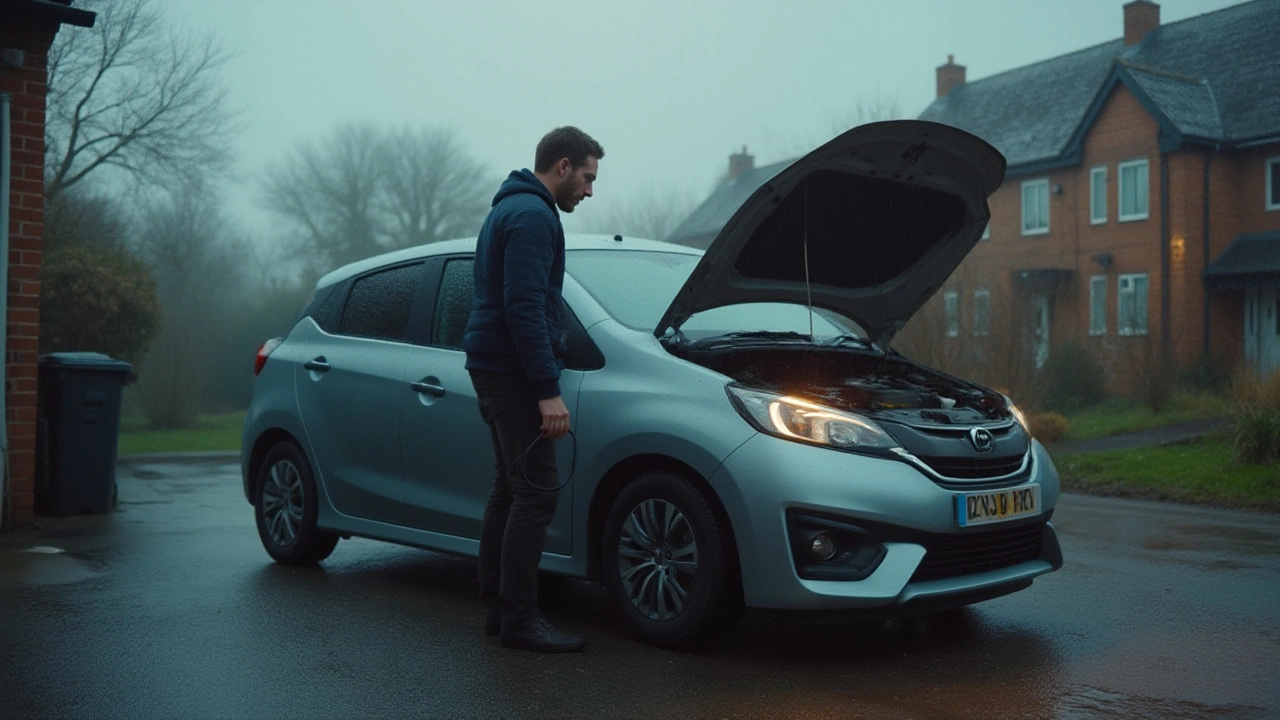If your car won't start on a rainy morning or your headlights suddenly look like they've lost the will to live, you're not alone. Most car batteries call it quits without much warning. One day, it's turning your engine like a champ; the next, it gives you the silent treatment. I'm not shy to admit that I've spent a night stranded outside a kebab shop because I ignored the warning signs. Trust me, a dodgy battery can ruin your plans far faster than bad weather. Knowing how to spot the signals can save you time, money, and a lot of headaches.
How Car Batteries Work and Why They Fail
Modern car batteries aren’t eternal; even the best ones have an expiration date. Most last about three to five years in typical UK conditions. The battery is the heart of your car's electrical system—providing the spark that gets you going and backing up all your gadgets. Under the bonnet, the battery's job is to provide enough cranking power to get your engine running, especially when it's cold or your car has sat idle for a while.
You might be surprised to learn cold weather is one of the biggest battery killers. A typical car battery will lose around 35% of its strength when temperatures drop below freezing. In Manchester, winter can be a real test. Hot weather isn’t much better; excessive heat can cause the battery fluid to evaporate, speeding up the internal wear. If you’re like me and love taking the family to the coast during heatwaves, your battery’s probably feeling the strain.
Most batteries in UK cars are lead-acid types. These work via a chemical reaction between lead plates and acid to create the electricity your car needs. Over time, the plates corrode and the chemicals get weaker. It’s like trying to make a brew with the same teabag for a week. You might get something out of it, but not what you want.
Another silent killer is short driving trips. If you mostly drive around town in short bursts, your battery never gets a full recharge. My mate who delivers pizzas learned this the hard way—his battery was always on its last legs. Leaving the radio, heated seats, or phone chargers plugged in while the engine’s off can also drain precious energy. If you don’t use your motor much, that alone is enough to age your battery well before it should.
Clear Signs Your Car Battery is Going Bad
Some battery problems sneak up on you, but some are still pretty easy to spot. The first thing you may notice is a sluggish start. If your engine sounds like it’s struggling rather than roaring to life, your battery is waving a white flag. Lights that flicker or look dim—especially headlights—are another big clue. Interior lights, dashboard displays, even your window wipers can all act up if the battery isn’t strong enough.
Here’s something few drivers realise: modern cars love their warning lights. If you see a little battery symbol glowing on your dash, it’s not just there for decoration. Ignore that at your own risk. Strange electronic behaviour—like central locking not working or infotainment systems playing up—can all trace back to low voltage from a failing battery.
You definitely don't want to smell rotten eggs under the bonnet. That strong, sulphuric scent is a sign of leaking battery acid. Left unchecked, acid can corrode other parts and cause expensive damage. Corrosion around the battery terminals, often seen as powdery white or blue deposits, can also choke the connections and stop the battery from delivering juice even if it has some left.
- Slow engine cranking or “clicking” sounds
- Headlights appear dimmer, especially when idling
- Warning lights on the dashboard, especially battery or engine icons
- Clicking noises or no sound at all on ignition
- Electronic accessories behaving oddly
- Swollen or warped battery case (more likely during heatwaves)
- Noticeable drop in the performance of wipers, windows or air conditioning
Don't fall for the myth that a battery can come back to life for good just because you gave it a jump-start. That's only a temporary fix. If any of these signs are familiar, your battery is on borrowed time.

Why Proper Testing Matters
You don’t need to be a master mechanic to judge your battery’s health, but a proper test gives you the facts. You can pick up a basic multimeter for less than a meal out. Testing the voltage is simple: with the engine off, place the meter across the battery terminals. A reading between 12.4 and 12.7 volts means things are fair. Anything below 12.2 volts is a red flag. If you check with the engine running and it reads over 14.7 volts, your alternator could be overcharging the battery, which is a different (but common) problem.
For those who want things visual, here’s how common voltages match up with battery health:
| Voltage (Engine Off) | Battery Condition |
|---|---|
| 12.7 - 12.6 | Fully charged—Good |
| 12.4 - 12.6 | 75% – 100% charged—Acceptable |
| 12.2 - 12.4 | Low charge—Needs charging soon |
| 12.0 - 12.2 | Partially discharged—Needs immediate attention |
| Below 12.0 | Discharged or dead—Replace battery |
If you don’t have a voltmeter, most local garages offer free battery health checks. Some even provide a printout showing "cranking amps"—the measure of power your battery delivers to start your car in the cold. Low cranking amps with normal voltage means your battery’s time is almost up.
Imogen always gets me to check her car’s battery before long trips. It only takes five minutes to avoid a stressful phone call (trust me, you don’t want to get that call). If you have any doubts, ask a garage to do a "load test"—that's where they really push your battery to see if it holds up under pressure. Most car parts shops will do this while you browse new air fresheners. If you see numbers below the factory specs—usually printed right on the battery—start planning a replacement.
Tips for Extending Your Car Battery Life
Your battery will thank you for a bit of TLC. Start by checking the terminals once a month. Clean off any corrosion with a baking soda and water solution using an old toothbrush. Make sure everything’s snug and the battery is fastened down. Loose connections cause both poor charging and extra vibration—both of which age your battery fast.
If your car sits parked for long spells, invest in a smart trickle charger. These keep your battery topped up without overcharging. Loads of taxis in Manchester use them when business is slow. If you’re planning a getaway for more than two weeks, disconnecting the negative terminal slows self-discharge, but remember you’ll lose your radio presets and other settings.
- Avoid lots of very short trips—combine errands when you can
- Turn off headlights, cabin lights, and accessories before shutting off the ignition
- Don’t leave gadgets charging in the car overnight
- Service the electrical system regularly—faults here can strain the battery
- After heavy rain or floods, check for any leaks or wet around the battery tray
- Replace your battery every four years, even if it “seems fine”—prevention is cheaper than recovery
According to a 2024 RAC survey, over 18% of UK roadside callouts in winter are for flat batteries. That’s almost one in five breakdowns on frosty mornings. Save their number just in case, but sensible maintenance can keep you out of that statistic.

When and How to Replace Your Battery
If your car is slow to start, electronic bits go weird, and tests show low power, don’t wait for total failure. Newer cars, especially hybrids or those with stop-start systems, use "advanced" AGM or EFB batteries—and these need to be replaced with the right type. Using the wrong battery can mess up the start-stop system or, worse, leave you stranded at the next traffic light.
Here’s a simple DIY swap if you’re into spanners:
- Make sure your car is switched off with the keys out.
- Wear gloves and old clothes—battery gunk can stain for days.
- Disconnect the car battery by removing the negative (black) cable first, then the positive (red).
- Take out the hold-down clamp and lift the battery free. They’re heavier than they look! Use both hands.
- Clean the tray and terminals before putting in the new battery.
- Reconnect positive (red) cable first, then negative (black).
- Double-check all is tight and secure. Start the car and make sure everything works.
If you’re dealing with an advanced battery or any doubts about alarms or electronics, let your local garage handle it. Either way, don’t push your luck with an old battery. Replacement costs vary, but peace of mind when it’s freezing at 6 am is priceless.
A flat battery in the middle of nowhere is the wrong time to learn the signs. Whether it’s your daily run to work or that weekend road trip with loved ones, keeping an eye—and a voltmeter—on your car battery means fewer surprises and more smooth miles ahead.

